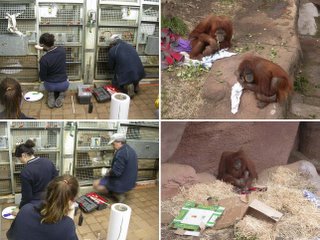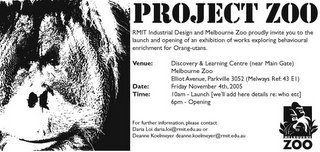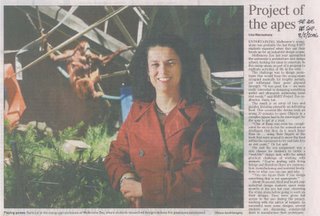This is an article by: Leif Cocks, Christine Baker, Grant Harris, and Fleur Butcher from the Perth Zoo Primate Section
At Perth Zoo, we integrate a daily and weekly schedule of behavioral enrichment for our orangutan colony, in order to maintain the animals' natural wild activity levels and therefore benefit their long-term mental health. The correct social environment, whether a large social group, a monogamous pairing, or a solitary lifestyle, is the best way to assure well-being for captive primates. They get the best stimulation and are less stressed when their social needs are taken into consideration. Foraging for food is the next most important factor. A large part of any primate's day in the wild is spent foraging for food; in captivity that source of activity is frequently removed by providing food once, twice, or three times a day, in large amounts. Variety of foods, textures, and tastes is as important as presentation. Variety and presentation in as close to the natural state as possible can be an important part of behavioral enrichment for nonhuman primates. One of the objectives of any behavioral enrichment program is to ensure that natural levels and times of activities approach the wild situation. It is critical to observe the levels and timing of activities, and to evaluate the success of any behavioral enrichment program by comparison to wild levels, if known.
There are four main types of behavioral enrichment to consider: * complex environment; * indestructible toys; * destructible toys; and * "work for food rewards". Positive reinforcement training is a separate category that can have immense benefits. A
complex environment involves functionally complex structures, using a variety of textures and diameters in climbing furniture, with vertical and horizontal components; movement of structures; platforms, nesting sites, and appropriate nesting materials; and ground covers and substrates.
Indestructible toys should be non-toxic, cheap and contain no lethal parts. To maintain their novelty, they should be rotated regularly. Examples include heavy duty plastic chairs, bin lids, crates, and boomer balls. One indestructible toy, often available free, is the industrial hard hat. Companies dispose of these regularly and, once the inner padding and strapping is removed, these are versatile toys for any type of primate, whether fixed as a hanging basket or loose.
Destructible toys should be cheap and readily available, and may often be donated. Examples include cardboard rolls, inserts, and boxes (from local stores), old telephone books (with popcorn inserted into pages and taped in), magazines (sachets removed, perfume sample pages left in), pine cones stuffed with popcorn, paper sacks rolled up and tied, and burlap sacks. "
Work for food reward" items should be low-calorie, small, and not ruin the animals' appetite for their main diet. A large variety of different treats can be alternated daily, such as raisins, popcorn, puffed wheat or rice, nuts in the shell, mixed dried fruit pieces, mixed nut kernels, sunflower seeds, and maize. The orangutans most prefer treats presented in puzzle boxes and dip tubes. The puzzle box we use is a steel box bolted to a climbing platform, with a welded mesh top, slots on one side and a steel maze inside. Treats are placed inside before the orangutans come out in the morning. They are given a 30-cm bamboo stick, which they use for the puzzle boxes and the dip tubes. We expected them to manipulate each treat through the maze and out through the slots. However, their ability to manipulate tools and solve problems has meant that they either spear each item and lift it through the mesh at the top, or herd all of the treats into one pile and take them through the maze in one operation, rather than one by one. The "dip tube" is a length of steel pipe welded to the orangs' climbing frame, with a padlocked screw-off cap at the base. The base holds honey, peanut butter, or a different flavor jam each day of the week. They dip for this with the bamboo stick in the same way that they dip for termites in the wild. One exhibit has a naturalistic-looking termite mound, made of sprayed-on concrete, with seven plastic tubes inserted and protruding into the internal chamber. The cap can be screwed onto a different tube each day. The orangs' browse feed is a source of much activity, and signals the end of the midday siesta (which seems to echo their wild patterns of activity). Later in the afternoon we throw sunflower seeds into the tall grass, which keeps them busy for an hour or so. Weekly activities include: * ice blocks in three layers: two layers of different flavored cordials, middle layer water with mixed dried fruit bits frozen within; * treat boxes: five cardboard boxes within boxes (like Russian dolls) taped up with three walnuts (or similar) inside the smallest; * giant bamboo cut into pieces, alternating one length sealed at both ends with one length open at each end (this utilizes all of the bamboo). The sealed sections have 3 or 4 holes drilled along the length and sunflower seeds poured in. The holes are plugged with dried apricots or figs. The unsealed sections are packed with a mixture of flour, water, and lots of sunflower seeds or maize kernels, which then sets very hard and must be picked out bit by bit. One item we sometimes use when orangutans need to be kept in the night quarters (e.g., while maintenance is carried out on the exhibit) is the PVC workstation. This consists of four PVC pipes about 2.5" in diameter, suspended horizontally one above the other, separated by about 10 cm. The pipes are bolted to two brackets, which are permanently fixed to the outside of the night quarters' wall mesh. The top pipe has wide holes drilled in the side facing the enclosure for primates to reach jam with a bamboo stick; the other three are a "move along and drop" series vertical maze. The device is mounted over the feed chute, so that the treats fall into the chute once the maze has been completed. This workstation would be suitable for any indoor quarters that are made of mesh. Positive reinforcement training is a labor-intensive activity for animal handlers and keepers, but has many positive outcomes. The relationship developed is one-on-one; it only involves positive reinforcement; the behaviors encouraged can be used for medical treatments; and it adds to the challenging environment that stimulates mental activity in primates. Behaviors we have trained include: * opening the mouth on command for inspection of teeth and gums; * presenting the shoulder or rump to accept an injection (we have used this successfully for a diabetic orangutan); * presenting a hand and accepting a lancet prick for a small amount of blood; * presenting the ear and holding still for a thermometer.





